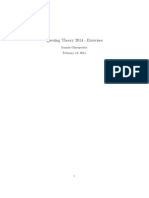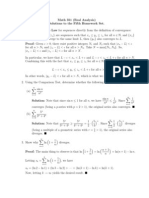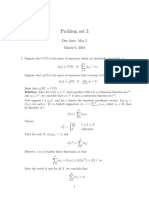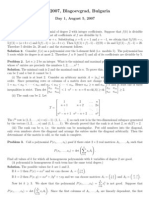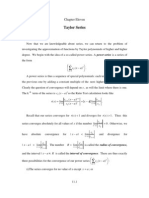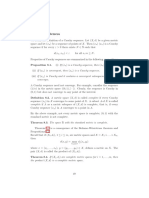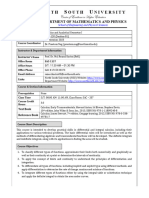Ternary Expansion
Ternary Expansion
Uploaded by
hjsndbe hxjdhCopyright:
Available Formats
Ternary Expansion
Ternary Expansion
Uploaded by
hjsndbe hxjdhCopyright
Available Formats
Share this document
Did you find this document useful?
Is this content inappropriate?
Copyright:
Available Formats
Ternary Expansion
Ternary Expansion
Uploaded by
hjsndbe hxjdhCopyright:
Available Formats
Ternary Expansions and the Cantor Set
Geometric Series: Recall a geometric series, which converges for all |a| < 1:
X
∞
1
ak =
k=0
1−a
This is a result of the telescoping formula
(1 − a)(1 + a + a2 + · · · + aN −1 ) = 1 − aN
When |a| < 1, taking the limit as N goes to infinity gives the geometric series formula.
1
We consider the special case where a = for p a natural number greater than or equal to 2.
p
When p = 2 we just have the familiar series:
1 1 1
1+ + + +··· = 2
2 4 8
This series also has the cool property that every tail of the series sums to exactly the previous
term before the tail:
1 1 1
1 = + + +···
2 4 8
1 1 1 1
= + + +···
2 4 8 16
1 1 1 1
= + + ···
2N 2N +1 2N +2 2N +3
This property is not unique, however. Let a = 1p . Prove that
X∞
p−1 1
k
= N (1)
k=N +1
p p
for any p ∈ N, p ≥ 2.
X
∞
p−1
Note that, in particular, = 1, regardless of the choice of p.
k=1
pk
Expansions of real numbers
Given p ≥ 2, take any series of the form
X
∞
ak
, ak ∈ {0, 1, . . . , p − 1}.
k=1
pk
Prove that this series converges to a real number in [0, 1].
Consider the space of all sequences {ak }∞
k=1 where ak ∈ {0, 1, . . . , p − 1}. The map
X
∞
ak
F : {ak }∞
k=1 7→ (2)
k=1
pk
is therefore a well-defined map from the space of such sequences to [0, 1]. We observe that F is
not quite injective. If x ∈ [0, 1] is of the form pqN where q ∈ N, q < P N , show that there are two
different sequences {ak }∞k=1 that F maps to x.
Next, we want to prove that F is surjective. Given any x ∈ [0, 1], prove (constructively) that
there exists a sequence {ak }∞
k=1 such that ak ∈ {0, 1, . . . , p − 1} for all k and
X
∞
ak
= x.
k=1
pk
Hint: observe that since the series consists of positive terms, the partial sums form a strictly
increasing sequence. Also, use Equation (1) above.
You can now describe a bijection between the interval [0, 1] and the space of sequences
{ak }∞
k=1 , ak ∈ {0, 1, . . . , p − 1}. When p = 10, the sequence is just exactly the decimal expansion
of the number x, for example,
1 4 1
x = 0.141592... = + 2 + 3 +··· ;
10 10 10
when p = 2 the sequence is called the binary expansion; when p = 3, it is the ternary expansion.
The Cantor Set
One way to view the Cantor ternary set is in terms of ternary expansions. Given x ∈ [0, 1],
there is a sequence of integers {ak }∞
k=1 , ak ∈ {0, 1, 2} such that the series
X
∞
ak
3k
k=1
converges to x. In other words, we can associate x to the ternary sequence
{a1 , a2 , a3 . . .}, ak ∈ {0, 1, 2}.
Prove that the Cantor ternary set is equal to the subset of [0, 1] consisting of all x which have
a ternary expansion for which ak ∈ {0, 2} for all k, i.e. the numbers which have an expansion
with no 1’s. (Read this carefully in the cases where x has two possible expansions. If x has one
ternary expansion which contains no 1’s, then it is in the Cantor set.)
Prove that the map we defined in class:
X
∞
ak X∞
bk ak
k
7→ bk =
k=1
3 k=1
2k 2
maps the Cantor ternary set C onto [0, 1], hence proving C is uncountable.
Prove that if a, b ∈ C, the Cantor ternary set, with a < b, then there exists a real number
r∈
/ C such that a < r < b. In other words, the Cantor set contains no intervals.
You might also like
- Functional Analysis SolutionsDocument43 pagesFunctional Analysis SolutionsOlulolo100% (1)
- Queuing Theory PDFDocument38 pagesQueuing Theory PDFNelson FicaNo ratings yet
- Introduction To Dynamical Systems, 2003Document250 pagesIntroduction To Dynamical Systems, 2003JamesFarrugia100% (4)
- Riemann Integration - An Introduction To Real AnalysisDocument17 pagesRiemann Integration - An Introduction To Real AnalysisUsman KabirNo ratings yet
- RandomDocument6 pagesRandomTytus MetryckiNo ratings yet
- Practice ClassesDocument48 pagesPractice ClassesfernadaNo ratings yet
- MD 23Document14 pagesMD 23Monsieur LNo ratings yet
- Infinite Series PDFDocument14 pagesInfinite Series PDFSunny KashyapNo ratings yet
- ch7suppsolDocument72 pagesch7suppsolBijay NagNo ratings yet
- Ex 5 Sol 475Document16 pagesEx 5 Sol 475Rohit GargNo ratings yet
- Infinite SeriesDocument11 pagesInfinite SeriesH100% (1)
- Freshman 14 SolDocument3 pagesFreshman 14 SolGag Paf100% (1)
- Ramanujan 1psi1Document5 pagesRamanujan 1psi1michael pasquiNo ratings yet
- Sophie Application SolutionsDocument4 pagesSophie Application SolutionsTanishNo ratings yet
- 351 Hw5solnDocument2 pages351 Hw5solnndtduongNo ratings yet
- Convexity Sec ProjDocument13 pagesConvexity Sec Projjipob11905No ratings yet
- HW7 ManualDocument19 pagesHW7 ManualDmitrii GudinNo ratings yet
- Absolutely Convergent Is Also ConvergentDocument1 pageAbsolutely Convergent Is Also ConvergentAzeemAnwarNo ratings yet
- 2 DP HandoutDocument41 pages2 DP HandoutAlessandro SinaiNo ratings yet
- Week 14Document4 pagesWeek 14홍석우No ratings yet
- 11 Ma 1 A Section 1 Mid Term SolDocument2 pages11 Ma 1 A Section 1 Mid Term SolJulian Ortega RamosNo ratings yet
- Solutions To The 78th William Lowell Putnam Mathematical Competition Saturday, December 2, 2017Document9 pagesSolutions To The 78th William Lowell Putnam Mathematical Competition Saturday, December 2, 2017ahmet çolakNo ratings yet
- Dirichlet TheoremDocument13 pagesDirichlet TheoremThịnh TrầnNo ratings yet
- AnalysisI Sheet5Document2 pagesAnalysisI Sheet5denizNo ratings yet
- hw3 SolnsDocument5 pageshw3 SolnsOm Mani Padme HumNo ratings yet
- hw7 Sol-1Document7 pageshw7 Sol-1licodo9896No ratings yet
- Alg Comb Lecture 4Document4 pagesAlg Comb Lecture 4Mihai FieraruNo ratings yet
- FA TA Week 3Document5 pagesFA TA Week 3linzexvaa44No ratings yet
- Solution Set4Document6 pagesSolution Set4Sakshi ChavanNo ratings yet
- HackerrankDocument4 pagesHackerrankMartin BajzekNo ratings yet
- EE3110 - Jul - 2024 - Tutorial 3 SolutionsDocument6 pagesEE3110 - Jul - 2024 - Tutorial 3 SolutionsShriram A ep23b019No ratings yet
- HW Jan 23 SolsDocument4 pagesHW Jan 23 SolsNguyễn Văn DũngNo ratings yet
- SM HW1Document5 pagesSM HW1saturnusfaunus54No ratings yet
- Feb PDFDocument9 pagesFeb PDFthonguyenNo ratings yet
- Dma 3 NotesDocument9 pagesDma 3 NotesSimon AndersenNo ratings yet
- putnam seqDocument6 pagesputnam seqcnokaf28No ratings yet
- 2024S Discrete Maths HW 5 SolutionDocument2 pages2024S Discrete Maths HW 5 SolutionarikilkovNo ratings yet
- Series Convergence Test RecapDocument5 pagesSeries Convergence Test Recap王健No ratings yet
- Quiz 2 SolutionDocument3 pagesQuiz 2 SolutionTumpa MitraNo ratings yet
- An Introduction To Numerical Mechanics: by J. WyldmannDocument13 pagesAn Introduction To Numerical Mechanics: by J. WyldmannAnonymous CEFIwCWNo ratings yet
- 4bb78e596328b2770b5a785ca3df3d0c_lec12Document8 pages4bb78e596328b2770b5a785ca3df3d0c_lec12andreigabe07No ratings yet
- The Convergence Acceleration of Two-Dimensional Fourier InterpolationDocument14 pagesThe Convergence Acceleration of Two-Dimensional Fourier InterpolationKate MossNo ratings yet
- Introduction To Probability TheoryDocument8 pagesIntroduction To Probability TheoryarjunvenugopalacharyNo ratings yet
- B 2 Stochasticprocesses 2020Document5 pagesB 2 Stochasticprocesses 2020ARISINA BANERJEENo ratings yet
- A.10 GENERALIZATIONS AND REFINEMENTS FOR BERGSTROM AND RADONS INEQUALITIESDocument6 pagesA.10 GENERALIZATIONS AND REFINEMENTS FOR BERGSTROM AND RADONS INEQUALITIESSong BeeNo ratings yet
- Day1 Solutions-2007Document3 pagesDay1 Solutions-2007setyowatissNo ratings yet
- Taylor Series: Chapter ElevenDocument7 pagesTaylor Series: Chapter ElevenRhea GoelNo ratings yet
- Math 202 SeriesDocument9 pagesMath 202 SeriesRaash MukherjeeNo ratings yet
- Complete Metric SpaceDocument14 pagesComplete Metric Spacekatherineoden14No ratings yet
- 6th RecurrenceDocument3 pages6th RecurrenceSaif Ali KhanNo ratings yet
- 2011 U of I Mock Putnam Contest SolutionsDocument5 pages2011 U of I Mock Putnam Contest SolutionsGag PafNo ratings yet
- Series and Matrices Assignment IIT MadrasDocument1 pageSeries and Matrices Assignment IIT MadrasVishwajit HegdeNo ratings yet
- AFA HW1 QsDocument4 pagesAFA HW1 Qsbx2xpvbqv8No ratings yet
- Notes403 8Document7 pagesNotes403 8Prakash SardarNo ratings yet
- Mathematical Foundations of Computer Science Lecture OutlineDocument5 pagesMathematical Foundations of Computer Science Lecture OutlineChenyang FangNo ratings yet
- Notes ch0Document12 pagesNotes ch0wzhengmath314No ratings yet
- Applicable Analysis and Discrete Mathematics: Some New Results Related To The Constant and FunctionDocument27 pagesApplicable Analysis and Discrete Mathematics: Some New Results Related To The Constant and FunctionbecejacslikeNo ratings yet
- Riemann Sums KoubaDocument5 pagesRiemann Sums KoubaZakaria KhayiouiNo ratings yet
- Week04Module03 FourierTransformsDocument13 pagesWeek04Module03 FourierTransformsrra127No ratings yet
- Dirac Delta Function ConvolutionDocument16 pagesDirac Delta Function ConvolutionAarthy Sundaram100% (1)
- Exm 2023Document12 pagesExm 2023olemas19840% (1)
- Performance Evaluation of PD and LQR Controller For Coupled Mass Spring Damper SystemDocument12 pagesPerformance Evaluation of PD and LQR Controller For Coupled Mass Spring Damper Systemrahul yadavNo ratings yet
- Question No. 1 (20 Marks) .: SolutionDocument6 pagesQuestion No. 1 (20 Marks) .: SolutionJonathon Raymond-SzewczukNo ratings yet
- Sequences: Using Maple To Generate Terms of A SequenceDocument19 pagesSequences: Using Maple To Generate Terms of A SequenceManuel Antonio Ramirez SansanoNo ratings yet
- Asymptotic Analysis of Algorithms (Growth of Function)Document8 pagesAsymptotic Analysis of Algorithms (Growth of Function)Rosemelyne WartdeNo ratings yet
- STD 9 Maths 1 Syllabus Summer AssignmentDocument7 pagesSTD 9 Maths 1 Syllabus Summer AssignmentrudreshNo ratings yet
- Kriging: Reservoir Modeling With GSLIBDocument16 pagesKriging: Reservoir Modeling With GSLIBskywalk189No ratings yet
- Advanced Quantum MechanicsDocument371 pagesAdvanced Quantum MechanicskavitarprNo ratings yet
- IMO 2008 NotesDocument8 pagesIMO 2008 Notesanmolratan982No ratings yet
- HW 10 202H SolutionsDocument4 pagesHW 10 202H SolutionsronaldhaiatNo ratings yet
- (PDF Download) Partition of Unity Methods: The Extended Finite Element Method St¿Phane Bordas Fulll ChapterDocument64 pages(PDF Download) Partition of Unity Methods: The Extended Finite Element Method St¿Phane Bordas Fulll Chaptermaemafaruga100% (5)
- SPM Clone (Quadratic Functions)Document2 pagesSPM Clone (Quadratic Functions)Saif IfNo ratings yet
- Observations On Eigenvalue BucklingDocument24 pagesObservations On Eigenvalue BucklingVenkatesh PulivarthiNo ratings yet
- 05 Bspline1Document8 pages05 Bspline1Praveen MathiNo ratings yet
- MJC JC 2 H2 Maths 2011 Mid Year Exam Solutions Paper 1Document22 pagesMJC JC 2 H2 Maths 2011 Mid Year Exam Solutions Paper 1jimmytanlimlongNo ratings yet
- Course Outline MAT 120Document3 pagesCourse Outline MAT 120Israt ZamanNo ratings yet
- Euler and SimpsonDocument14 pagesEuler and SimpsonEdward SmithNo ratings yet
- Cens RegDocument12 pagesCens RegLucía AndreozziNo ratings yet
- Programmi Svolti PythonDocument84 pagesProgrammi Svolti PythonGrezooNo ratings yet
- Free SAT Math Level 2 Subject TestDocument16 pagesFree SAT Math Level 2 Subject TestRuqia ElshennawyNo ratings yet
- Mechanical Vibration TopicsDocument1 pageMechanical Vibration TopicsMushfique Naaz100% (1)
- 9Document26 pages9Jainam11No ratings yet
- ContinuityDocument49 pagesContinuityBuyNo ratings yet
- Ex No: 5 Curve Fitting Using Polynomial Regression: DescriptionDocument5 pagesEx No: 5 Curve Fitting Using Polynomial Regression: DescriptionAvinash ChoudharyNo ratings yet
- Complex Analysis: Section 6: Series and ResiduesDocument21 pagesComplex Analysis: Section 6: Series and ResiduesMardan Ameen PirdawoodNo ratings yet
- Solutions Examination Calculus I For AE (wi1421LR), Part BDocument2 pagesSolutions Examination Calculus I For AE (wi1421LR), Part BAnon ymousNo ratings yet

